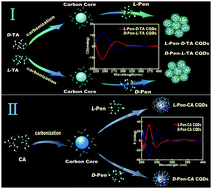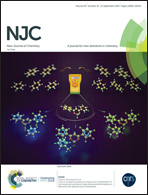A universal strategy to obtain chiroptical carbon quantum dots through the optically active surface passivation procedure†
Abstract
Inspired by the knowledge that a nonchiral metal nanocrystal could be bestowed with chirality when the metal nanocrystal and the chiral molecules form complexes, in this contribution, a two-step pyrolytic route to obtain chiroptical carbon quantum dots (CQDs) was attempted through the optically active surface passivation procedure with enantiomers. Here, tartaric acid (TA) and citric acid (CA), one being a chiral molecule and the other being an achiral molecule, were used as carbon sources to produce a carbon core, respectively, and D/L-penicillamine (D/L-Pen) molecules were utilized as chiral ligands to further passivate it in the two-step pyrolytic route. The strategy is applicative no matter whether the carbon source is from chiral or achiral molecules during the first carbonization step. Also, the second pyrolytic reaction temperature, lower than the melting point of the surface passivation enantiomeric ligand, is critical to preserve the chiral information and to generate the chiral centers of the CQDs. Based on this simple approach, it is possible to envision the design and fabrication of new types of more sophisticated optically active photoluminescence carbon nanodots, which may be applied in chiral catalysis, chiral recognition and sensing.



 Please wait while we load your content...
Please wait while we load your content...